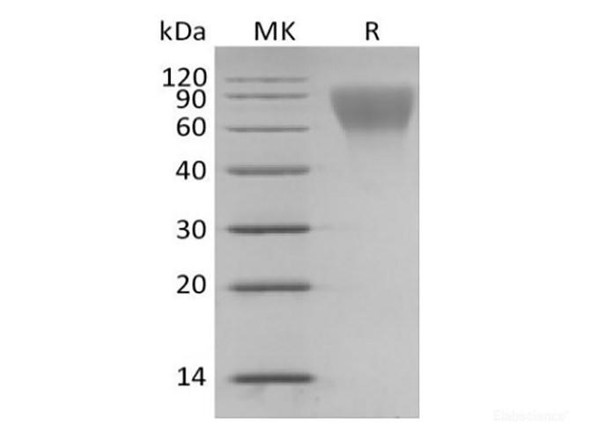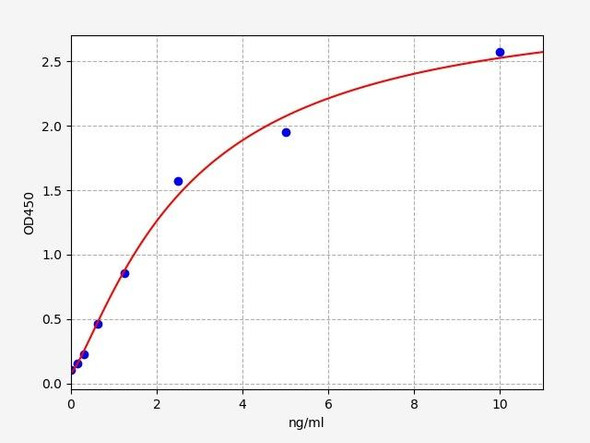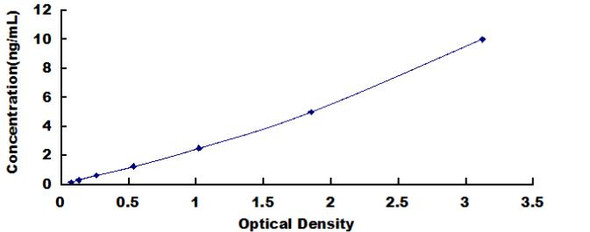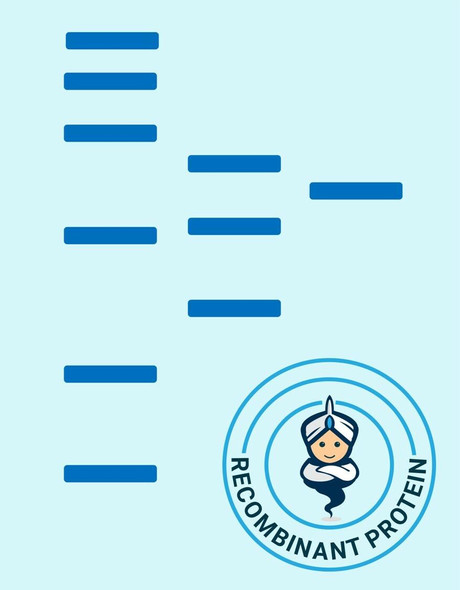Human Hematopoietic progenitor cell antigen CD34 (CD34) ELISA Kit (HUEB2064)
- SKU:
- HUEB2064
- Product Type:
- ELISA Kit
- Size:
- 96 Assays
- Uniprot:
- P28906
- Range:
- 0.156-10 ng/mL
- ELISA Type:
- Sandwich
- Synonyms:
- CD34, Hematopoietic progenitor cell antigen CD34, HPCA1, CD34 antigenhematopoietic progenitor cell antigen CD34, CD34 molecule
- Reactivity:
- Human
Description
Human Hematopoietic progenitor cell antigen CD34 (CD34) ELISA Kit
The Human Hematopoietic Progenitor Cell Antigen CD34 (CD34) ELISA Kit is a comprehensive tool for detecting and quantifying CD34 levels in human cells and samples. This kit is specifically designed to provide accurate and reliable results for researchers studying hematopoietic progenitor cells and their antigen expression.CD34 is an important cell surface marker commonly found on hematopoietic stem cells and progenitor cells. Its expression is indicative of early stages of hematopoiesis and is a key factor in various hematologic disorders and conditions.
By accurately measuring CD34 levels, researchers can gain valuable insights into cell differentiation, proliferation, and disease progression.The CD34 ELISA Kit offers high sensitivity and specificity, allowing for precise measurements of CD34 levels in serum, plasma, and cell culture supernatants. With its ease of use and robust performance, this kit is an essential tool for advancing research in hematology, immunology, and stem cell biology.
| Product Name: | Human Hematopoietic progenitor cell antigen CD34 (CD34) ELISA Kit |
| SKU: | HUEB2064 |
| Size: | 96T |
| Target: | Human Hematopoietic progenitor cell antigen CD34 (CD34) |
| Synonyms: | CD34 |
| Assay Type: | Sandwich |
| Detection Method: | ELISA |
| Reactivity: | Human |
| Detection Range: | 0.156-10ng/mL |
| Sensitivity: | 0.1ng/mL |
| Intra CV: | 4.6% | ||||||||||||||||||||
| Inter CV: | 7.1% | ||||||||||||||||||||
| Linearity: |
| ||||||||||||||||||||
| Recovery: |
| ||||||||||||||||||||
| Function: | Possible adhesion molecule with a role in early hematopoiesis by mediating the attachment of stem cells to the bone marrow extracellular matrix or directly to stromal cells. Could act as a scaffold for the attachment of lineage specific glycans, allowing stem cells to bind to lectins expressed by stromal cells or other marrow components. Presents carbohydrate ligands to selectins. |
| Uniprot: | P28906 |
| Sample Type: | Serum, plasma, tissue homogenates, cell culture supernates and other biological fluids |
| Specificity: | Natural and recombinant human Hematopoietic progenitor cell antigen CD34 |
| Research Area: | Cancer |
| Subcellular Location: | Membrane Single-pass type I membrane protein |
| Storage: | Please see kit components below for exact storage details |
| Note: | For research use only |
| UniProt Protein Function: | CD34: Possible adhesion molecule with a role in early hematopoiesis by mediating the attachment of stem cells to the bone marrow extracellular matrix or directly to stromal cells. Could act as a scaffold for the attachment of lineage specific glycans, allowing stem cells to bind to lectins expressed by stromal cells or other marrow components. Presents carbohydrate ligands to selectins. Selectively expressed on hematopoietic progenitor cells and the small vessel endothelium of a variety of tissues. Belongs to the CD34 family. 2 isoforms of the human protein are produced by alternative splicing. |
| UniProt Protein Details: | Protein type:Cell surface; Membrane protein, integral Chromosomal Location of Human Ortholog: 1q32 Cellular Component: intercellular bridge; integral to plasma membrane; lysosome; perinuclear region of cytoplasm; apical plasma membrane; cytoplasm; basal plasma membrane; plasma membrane; external side of plasma membrane Molecular Function:sulfate binding; carbohydrate binding; transcription factor binding Biological Process: positive regulation of odontogenesis; regulation of immune response; negative regulation of nitric oxide biosynthetic process; glomerular filtration; cell motility involved in cell locomotion; negative regulation of blood coagulation; negative regulation of tumor necrosis factor production; signal transduction; positive regulation of interleukin-10 production; cell proliferation; cell-cell adhesion; positive regulation of angiogenesis; endothelial cell proliferation; regulation of blood pressure; tissue homeostasis; hemopoiesis; leukocyte migration |
| NCBI Summary: | The protein encoded by this gene may play a role in the attachment of stem cells to the bone marrow extracellular matrix or to stromal cells. This single-pass membrane protein is highly glycosylated and phosphorylated by protein kinase C. Two transcript variants encoding different isoforms have been found for this gene. [provided by RefSeq, Aug 2011] |
| UniProt Code: | P28906 |
| NCBI GenInfo Identifier: | 3183511 |
| NCBI Gene ID: | 947 |
| NCBI Accession: | P28906.2 |
| UniProt Secondary Accession: | P28906,Q15970, Q15971, Q5JTA3, Q5JTA4, Q9UJB1, A8K664 |
| UniProt Related Accession: | P28906 |
| Molecular Weight: | 35,011 Da |
| NCBI Full Name: | Hematopoietic progenitor cell antigen CD34 |
| NCBI Synonym Full Names: | CD34 molecule |
| NCBI Official Symbol: | CD34 |
| NCBI Protein Information: | hematopoietic progenitor cell antigen CD34; CD34 antigen |
| UniProt Protein Name: | Hematopoietic progenitor cell antigen CD34 |
| UniProt Synonym Protein Names: | CD_antigen: CD34 |
| Protein Family: | Hematopoietic progenitor cell antigen |
| UniProt Gene Name: | CD34 |
| UniProt Entry Name: | CD34_HUMAN |
| Component | Quantity (96 Assays) | Storage |
| ELISA Microplate (Dismountable) | 8×12 strips | -20°C |
| Lyophilized Standard | 2 | -20°C |
| Sample Diluent | 20ml | -20°C |
| Assay Diluent A | 10mL | -20°C |
| Assay Diluent B | 10mL | -20°C |
| Detection Reagent A | 120µL | -20°C |
| Detection Reagent B | 120µL | -20°C |
| Wash Buffer | 30mL | 4°C |
| Substrate | 10mL | 4°C |
| Stop Solution | 10mL | 4°C |
| Plate Sealer | 5 | - |
Other materials and equipment required:
- Microplate reader with 450 nm wavelength filter
- Multichannel Pipette, Pipette, microcentrifuge tubes and disposable pipette tips
- Incubator
- Deionized or distilled water
- Absorbent paper
- Buffer resevoir
*Note: The below protocol is a sample protocol. Protocols are specific to each batch/lot. For the correct instructions please follow the protocol included in your kit.
Allow all reagents to reach room temperature (Please do not dissolve the reagents at 37°C directly). All the reagents should be mixed thoroughly by gently swirling before pipetting. Avoid foaming. Keep appropriate numbers of strips for 1 experiment and remove extra strips from microtiter plate. Removed strips should be resealed and stored at -20°C until the kits expiry date. Prepare all reagents, working standards and samples as directed in the previous sections. Please predict the concentration before assaying. If values for these are not within the range of the standard curve, users must determine the optimal sample dilutions for their experiments. We recommend running all samples in duplicate.
| Step | |
| 1. | Add Sample: Add 100µL of Standard, Blank, or Sample per well. The blank well is added with Sample diluent. Solutions are added to the bottom of micro ELISA plate well, avoid inside wall touching and foaming as possible. Mix it gently. Cover the plate with sealer we provided. Incubate for 120 minutes at 37°C. |
| 2. | Remove the liquid from each well, don't wash. Add 100µL of Detection Reagent A working solution to each well. Cover with the Plate sealer. Gently tap the plate to ensure thorough mixing. Incubate for 1 hour at 37°C. Note: if Detection Reagent A appears cloudy warm to room temperature until solution is uniform. |
| 3. | Aspirate each well and wash, repeating the process three times. Wash by filling each well with Wash Buffer (approximately 400µL) (a squirt bottle, multi-channel pipette,manifold dispenser or automated washer are needed). Complete removal of liquid at each step is essential. After the last wash, completely remove remaining Wash Buffer by aspirating or decanting. Invert the plate and pat it against thick clean absorbent paper. |
| 4. | Add 100µL of Detection Reagent B working solution to each well. Cover with the Plate sealer. Incubate for 60 minutes at 37°C. |
| 5. | Repeat the wash process for five times as conducted in step 3. |
| 6. | Add 90µL of Substrate Solution to each well. Cover with a new Plate sealer and incubate for 10-20 minutes at 37°C. Protect the plate from light. The reaction time can be shortened or extended according to the actual color change, but this should not exceed more than 30 minutes. When apparent gradient appears in standard wells, user should terminatethe reaction. |
| 7. | Add 50µL of Stop Solution to each well. If color change does not appear uniform, gently tap the plate to ensure thorough mixing. |
| 8. | Determine the optical density (OD value) of each well at once, using a micro-plate reader set to 450 nm. User should open the micro-plate reader in advance, preheat the instrument, and set the testing parameters. |
| 9. | After experiment, store all reagents according to the specified storage temperature respectively until their expiry. |
When carrying out an ELISA assay it is important to prepare your samples in order to achieve the best possible results. Below we have a list of procedures for the preparation of samples for different sample types.
| Sample Type | Protocol |
| Serum | If using serum separator tubes, allow samples to clot for 30 minutes at room temperature. Centrifuge for 10 minutes at 1,000x g. Collect the serum fraction and assay promptly or aliquot and store the samples at -80°C. Avoid multiple freeze-thaw cycles. If serum separator tubes are not being used, allow samples to clot overnight at 2-8°C. Centrifuge for 10 minutes at 1,000x g. Remove serum and assay promptly or aliquot and store the samples at -80°C. Avoid multiple freeze-thaw cycles. |
| Plasma | Collect plasma using EDTA or heparin as an anticoagulant. Centrifuge samples at 4°C for 15 mins at 1000 × g within 30 mins of collection. Collect the plasma fraction and assay promptly or aliquot and store the samples at -80°C. Avoid multiple freeze-thaw cycles. Note: Over haemolysed samples are not suitable for use with this kit. |
| Urine & Cerebrospinal Fluid | Collect the urine (mid-stream) in a sterile container, centrifuge for 20 mins at 2000-3000 rpm. Remove supernatant and assay immediately. If any precipitation is detected, repeat the centrifugation step. A similar protocol can be used for cerebrospinal fluid. |
| Cell culture supernatant | Collect the cell culture media by pipette, followed by centrifugation at 4°C for 20 mins at 1500 rpm. Collect the clear supernatant and assay immediately. |
| Cell lysates | Solubilize cells in lysis buffer and allow to sit on ice for 30 minutes. Centrifuge tubes at 14,000 x g for 5 minutes to remove insoluble material. Aliquot the supernatant into a new tube and discard the remaining whole cell extract. Quantify total protein concentration using a total protein assay. Assay immediately or aliquot and store at ≤ -20 °C. |
| Tissue homogenates | The preparation of tissue homogenates will vary depending upon tissue type. Rinse tissue with 1X PBS to remove excess blood & homogenize in 20ml of 1X PBS (including protease inhibitors) and store overnight at ≤ -20°C. Two freeze-thaw cycles are required to break the cell membranes. To further disrupt the cell membranes you can sonicate the samples. Centrifuge homogenates for 5 mins at 5000xg. Remove the supernatant and assay immediately or aliquot and store at -20°C or -80°C. |
| Tissue lysates | Rinse tissue with PBS, cut into 1-2 mm pieces, and homogenize with a tissue homogenizer in PBS. Add an equal volume of RIPA buffer containing protease inhibitors and lyse tissues at room temperature for 30 minutes with gentle agitation. Centrifuge to remove debris. Quantify total protein concentration using a total protein assay. Assay immediately or aliquot and store at ≤ -20 °C. |
| Breast Milk | Collect milk samples and centrifuge at 10,000 x g for 60 min at 4°C. Aliquot the supernatant and assay. For long term use, store samples at -80°C. Minimize freeze/thaw cycles. |
| ELISA |
| Human CD34 ELISA Kit |










